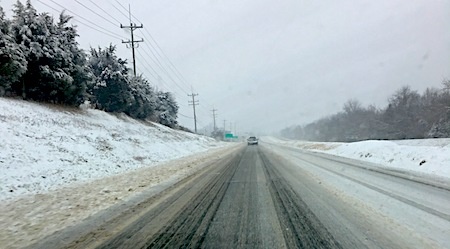
Page County Public Schools closed Tuesday, Feb. 11
~ PVN staff report
LURAY, Feb. 10 — A Winter Storm Warning is in affect for the Page Valley over the next two days. Governor Youngkin declared a State of Emergency Monday morning in advance of the winter storm. Monday afternoon Page County Public Schools issued a notice that all classes and activities were canceled for Tuesday, Feb. 11.
“With another round of winter weather across the state this week forecasted to bring heavy snow and ice, I am declaring a state of emergency so we can move resources around the state,” said Governor Glenn Youngkin after Monday’s declaration. “I urge all Virginians to monitor your local forecast and to prepare for possible impacts to roadways and infrastructure beginning overnight Monday throughout Tuesday.”
The Winter Storm Warning is in effect from 11 a.m. on Tuesday through 7 a.m. on Wednesday, with snowfall projections ranging from 4 to 6 inches of accumulation in the area.
“Motorists should avoid travel on Tuesday, February 11 due to forecasted heavy snow in the Shenandoah Valley and Alleghany Highlands. In some areas sleet and freezing rain may also occur. Expect hazardous driving conditions,” reads a notice from the Virginia Department of Transportation (VDOT) on Monday afternoon. “It is important to stay off roadways and let snow removal crews work. All travel should occur before or after this weather event. [VDOT] Staunton District crews and contractors will monitor, plow and treat roads as needed.”
The National Weather Service forecasts are predicting areas of accumulating snow, freezing rain, ice, and excessive rainfall that could cause flooding, power outages, and hazardous travel conditions. To coordinate the state’s response activities, the Virginia Emergency Support Team will be activated, according to the Governor’s statement.
Bridges and overpasses will freeze first. The public should also be alert for falling tree limbs and tree debris on roadways from heavy wet snow or ice.
Road-clearing priorities are as follows:
- The Interstate Highway System and limited-access roadways are our first priority.
- Primary roads and major secondary roads with vital emergency and public facilities, or those with high-traffic volumes, will be cleared along with interstate and limited-access roadways as resources allow.
- Low-volume secondary roads and subdivision streets will be treated after higher-priority routes are completed and additional resources are available.
Check 511 at its updated URL and website: https://511.vdot.virginia.gov/. The 511 site has traffic cameras, current crash locations, weather conditions and more. The public can sign-up for 511 alerts to be sent to their personal device. On the VDOT 511 website roads with snow and ice conditions will be marked minor, moderate, severe or closed.
Another information source is the VDOT website at https://www.vdot.virginia.gov. Type in “winter weather” in the search bar located in the middle of the home page. Follow the links to the winter page for driving tips, snow removal procedures, travel kit items and additional resources.
To view a text listing of weather road conditions go to https://511.vdot.virginia.gov/, look at the blue bar on the top of the page and click on “Road Reports” and then click on “Road Conditions”. Look at the pull down box that lists all jurisdictions. In this box individual counties can be chosen to view. Apps for Virginia’s 511 system are also available for android and iOS devices.
The VDOT Customer Service Center can be accessed through its mobile friendly website at https://my.vdot.virginia.gov/. Agents are on site 24/7 every day of the year to assist the public. People can also call the VDOT Customer Service Center at 800-FOR- ROAD (800-367-7623).
The Staunton District X (Twitter) feed is at @VaDOTStaunton. The VDOT Staunton District has a group page on Facebook. Follow VDOT statewide accounts on Facebook, Flickr, and YouTube.
If having to travel during the storm, drivers are reminded to do the following:
- Use headlights. Increasing your visibility helps you to avoid slick and dangerous spots on the road, as well as helps other drivers see you better.
- Slow your speed. Though state police works closely with the Virginia Department of Transportation (VDOT) to identify problem areas on Virginia’s highways during a winter storm, drivers still must drive for conditions. Slowing your speed gives you more time to safely react and avoid a crash. Drive your vehicle based on your ability to properly maintain control of your vehicle.
- Don’t tailgate. You need increased stopping distance on slick road surfaces. Give yourself more space between vehicles traveling ahead of you to avoid rear end collisions.
- Buckle Up. Most crashes that occur during winter weather are caused by vehicles sliding into guardrails, off the road or other vehicles. Wearing your seat belt protects you from being thrown around the inside of your vehicle and suffering serious injury in a crash.
- Check Your Vehicle. Make sure your vehicle is in good working order for the conditions. Fill up the tank in advance. Check windshield wipers, windshield wiper fluid, tire tread, battery life, etc.
- Don’t leave home without a window scraper, blanket, bottled water, snack, cell phone charger and flashlight.
Personal Preparedness Actions
- During a winter storm, stay off the roads as much as possible and only drive when absolutely necessary. Always give snowplows and responders the right of way.
- Never use a generator, grill, camp stove or gasoline, propane, natural gas or charcoal burning device inside your home, garage, basement, crawlspace or any other partially enclosed area.
- Snow shoveling is a known trigger for heart attacks. Always avoid overexertion when shoveling.
- When severe weather occurs, plan to check on elderly or disabled neighbors and relatives.
- If you must travel, know road conditions before you leave home. Visit 511.vdot.virginia.gov, check the 511 Virginia mobile app, or call 511 while in Virginia for information on road and traffic conditions.
- Protect yourself from Frostbite. Hands, feet and face are the most commonly affected areas so wear a hat, mittens (which are warmer than gloves) and cover your mouth with a scarf to reduce heat loss.
- Keep dry. Change out of wet clothing frequently to prevent a loss of body heat.
- Wear several layers of loose-fitting, lightweight, warm clothing rather than one layer or heavy clothing.
- Prepare your home
- Make sure your home is properly insulated
- Check the weather stripping around your windows and doors
- Learn how to shut off water valves in case a pipe bursts
- Have additional heat sources on hand in case of a power outages
- Keep a fire extinguisher accessible
- Replace the batteries in your Carbon Monoxide detector annually
- Prepare your car
- Batteries lose power as temperatures drop, be sure to have yours tested
- Check your car’s antifreeze level
- Have your radiator system serviced
- Replace your car’s windshield wiper fluid with a wintertime mix
- Proactively replace your car’s worn tires and wiper blades
- To help with visibility, clean off your car entirely – including your trunk, roof, windows and headlights
- Please heed warnings to avoid travel. If you absolutely have to be on the roadway, prepare your vehicle and have a kit for you and your passengers. This could include items such as:
- Blankets
- Drinking water and snacks for everyone in the car, including pets
- Boots
- Basic first-aid kit
- Warm coat and insulating layers (sweatpants, gloves, hat, socks,)
- Rags, paper towels or pre-moistened wipes
- Basic set of tools
- Car emergency warning devices such as road flares or reflectors
- Ice scraper/snow brush
- Jumper cables/jump pack
- Fire extinguisher
- Cash
- Items for children such as diapers, baby wipes, toys, etc.
- Flashlight, with extra batteries
- Hand warmers
- Paper map
- Portable smartphone power bank
- Extra medication
- Garbage bags
- Traction aid such as sand, salt or non-clumping cat litter
- Tarp, raincoat and gloves
- Shovel
To learn more about how to prepare yourself, your family, and your business for winter weather, visit www.vaemergency.gov/winter-weather. For real-time traffic conditions anywhere in the state, dial 5-1-1 or visit 511.vdot.virginia.gov.
Power Outages
- To report an outage, please contact your service provider
- Check with your provider directly to determine repair schedules
- For more information and tips on what actions to take during a power outage, please visit: https://www.ready.gov/power-outages
Emergency Alerts
These days, emergency alerts can reach you in so many ways–WEA (Wireless Emergency Alerts) come to your cell phone, EAS (Emergency Alert System) on TV and Radio, NOAA weather radio alerts, mobile apps and more. It’s important to have several different ways you can receive emergency alerts, and to be armed with the knowledge you need before an emergency happens.
- Know the current forecast and get alerted for any watches, warnings, or advisories on the National Weather Service’s website
- Download FEMA app and local news apps for severe weather alerts
- Sign up to receive alerts on your phone, tune in to your local weather station, or listen to your NOAA Weather Radio
•••
RELATED ARTICLES



Be the first to comment